


One night last autumn, I watched the moon rise heavy and full. As it climbed higher and higher it cast its light upon a stand of native poplars where the leaves hung in colourful array of bright green and vivid yellow. The scene set me to remembering many a similar view during the years that I spent in Saskatchewan's northern wilderness. Recalled with remarkable clarity were many moonlit scenes of woods and water and hills far to the north of my present home.
This book deals with that part of Saskatchewan's north central area which begins at the commercial forest belt near the city of Prince Albert and extends over three hundred miles of wooded wilderness to the north to end in the jack pine forests to the north of Cree Lake. The story begins in the autumn of 1932 and ends in the spring of 1939. For centuries the old established routes of the fur trade had existed on the Churchill River, the Athabasca to the west, and Reindeer Lake to the east, yet the area concerned in this book had seen comparatively little travel. Ancient canoe routes made access to this region possible in summer, but few men ventured there, for the way was long and treacherous to the uninitiated, the work hard and punishing.
All portages at the rapids were marked by footpaths, well worn through the moss down to the sand and rock beneath, made by the feet of laden packers: Indian, Metis and white men who had toiled here through the centuries. There were no wheel marks or rails anywhere within hundreds of miles to alter the appearance of the ground from what it had been before any white men had passed this way. When the prairies to the south were being settled, largely by white European immigrants, the search for farmland drove the late comers north to the parklands and into the fringes of the commercial forest. Here I saw evidence that the wave had sucked back a little, foiled by the thick stands of big trees, extra tough roots, rocks, swamps, and muskeg. Mosquitoes, black flies, bulldog flies, and sand flies tormented the homesteaders and their livestock beyond belief in summer. The farmers left this land to the Indians and the Metis of mixed Indian and white blood, the commercial fishermen, the loggers, and the white trappers. Some of these people, although they ranged extensively as far as the Churchill River, did not venture in appreciable numbers any great distance beyond. A few traveled into the coniferous forest that extends all the way to Lake Athabasca and beyond the northwest corner of Saskatchewan. Fewer still were those who journeyed into the thin taiga forest to the northeast past Wollaston and Reindeer lakes, the taiga that dwindles and is replaced farther to the northeast by the Arctic tundra.
The barren ground caribou or reindeer migrated in the hundreds of thousands to this region in the dead of winter far from their summer range on the tundras to the north. This fact was at that time unknown to most of Saskatchewan's southern residents. Already there were few places in this land that did not show evidence of visitation by humans, for a few white men had wandered through the country long before the southern wheatlands had been settled. Trading posts at Green Lake and Ile-A-La-Crosse were in business well before the homestead era, for the fur trade was established long before wheat was exported. There had been some prospecting activity. In 1935, a trapper told me he had seen the neat round holes of a diamond drill in the big rock outcroppings near Porter Lake, some distance north of the Churchill River. A producing gold mine existed on the north shore of Lake Athabasca.
Today, great earth-moving machines are gouging into the vast tar sands near Fort McMurray in Alberta just west of the area concerned. In Saskatchewan, highways are steadily creeping northward. Although it is economically sobering to build a mile of highway through Precambrian rock, it is but a matter of time until roads will be built through the region and the old north of the white trapper will be dead. Then will follow the big game hunters, the sports fishermen, tourists, filling stations, motels, and littered campsites. This story happened long before the news was circulated via American sports magazines of the tremendous sport fishing that is to be found all the way from the parklands to the Arctic coast. As a boy still in my teens, I entered the precincts of this land. I came as a greenhorn and through seven years traveled its then unmapped lakes and rivers over its muskegs and through its woods and by actual experience gained a firsthand knowledge of the ways of the North, its moods, its bounty, its unproductiveness, its pitfalls and terrors, and some of its secrets. Just old enough to read, I became fascinated by the fur price lists that came by mail from the big fur companies. 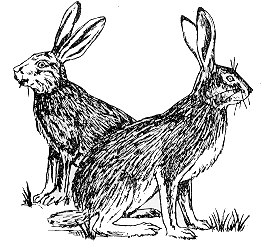
Listed were the furbearing animals native to that part of the prairies where I lived. I knew of coyote, badger, skunk, weasel, muskrat, and jackrabbit but what of the silver, cross, and red foxes? What about mink, otter, beaver, marten, fisher, lynx, timber wolf, wolverine, bear? These were not found on the bald prairie in those days. I learned that they were native to the wooded country far to the north. I had developed a healthy interest in hunting and trapping by the time I could legally carry a rifle. In company with my older brother, Ab, I stalked the big prairie hares or jackrabbits by tracking them in the snow until we located them sometimes sitting in the open with their backs to the winter wind. Ab often awed me with the way he could pick them off with a .22 rifle at long range with open sights, a talent that was to be a great asset to us in later years. Thoughts of stalking a bull moose or trapping wolves excited us to the point where we vowed someday to see the northern part of our province for ourselves. The fact that most of the world was in a state of economic stagnation that some called the Great Depression, gave us a logical reason to go north. There were no jobs in our small town. We had grown to manhood and since civilization apparently had nothing to offer we decided to escape its tentacles. It was demonstrated quite clearly to me that in the deepest wilderness one could expect, at any time, a visit from the devil. The Chipewyan Indians, I learned later, were acutely aware of his presence, spoke of him often and called him Dishlini. |
| Deep River Fur Farm |
| Deep River Trapping Page |
| Deep River Fishing Page |
| My Norwegian Roots |
| Early Mink People Canada - Bowness |
| The Manager's Tale - Hugh Ross |
| Sakitawak Bi-Centennial - 200 Yrs. |
| Lost Land of the Caribou - Ed Theriau |
| The History of Buffalo Narrows |
| Hugh (Lefty) McLeod, Bush Pilot |
| George Greening, Bush Pilot |
| Timber Trails - History of Big River |
| Joe Anstett, Trapper |
| Bill Windrum, Bush Pilot |
| Face the North Wind - Art Karas |
| North to Cree Lake - Art Karas |
| Look at the Past - History Dore Lake |
| George Abbott Family History |
| These Are The Prairies |
| William A. A. Jay, Trapper |
| John Hedlund, Trapper |
| Deep River Photo Gallery |
| Cyril Mahoney, Trapper |
| Saskatchewan Pictorial History |
| Who's Who in furs - 1956 |
| Century in the Making - Big River |
| Wings Beyond Road's End |
| The Northern Trapper, 1923 |
| My Various Links Page |
| Ron Clancy, Author |
| Roman Catholic Church - 1849 |
| Frontier Characters - Ron Clancy |
| Northern Trader - Ron Clancy |
| Various Deep River Videos |
| How the Indians Used the Birch |
| Mink and Fish - Buffalo Narrows |
| Gold and Other Stories - Richards |
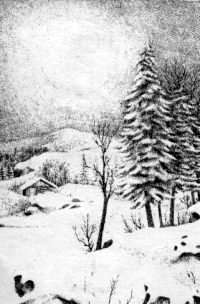 The moon had lighted similar views for the first white men ever to enter this land. Here, I thought, was something that had not changed. Thoughts of the present were crowded out by memories of yesteryear. I lowered my gaze and for a time I studied the autumn colours of the poplars where the leaves shook a little in the night breeze. Sometime later I looked again at the moon. The vapour trail of a jet aircraft cut directly across the moon's face. This book was written from memory of events that happened before Man was literally reaching for the moon. The locale of the story is an area where no tin cans, or bottles, or paper, or other man-made litter was to be found at the places where the few human residents made their campfires. Here charred wood, wood chips, stumps, and axe blazed trees and a bit of discarded buckskin would likely be the only evidence of human visitation, for this land had not received an influx of tourists, or developers, or promoters, or sportsmen, or despoilers.
The moon had lighted similar views for the first white men ever to enter this land. Here, I thought, was something that had not changed. Thoughts of the present were crowded out by memories of yesteryear. I lowered my gaze and for a time I studied the autumn colours of the poplars where the leaves shook a little in the night breeze. Sometime later I looked again at the moon. The vapour trail of a jet aircraft cut directly across the moon's face. This book was written from memory of events that happened before Man was literally reaching for the moon. The locale of the story is an area where no tin cans, or bottles, or paper, or other man-made litter was to be found at the places where the few human residents made their campfires. Here charred wood, wood chips, stumps, and axe blazed trees and a bit of discarded buckskin would likely be the only evidence of human visitation, for this land had not received an influx of tourists, or developers, or promoters, or sportsmen, or despoilers.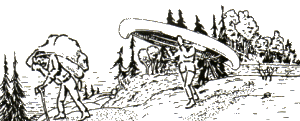 It was upstream traveling much of the way, through swift-flowing rivers with much portaging and tracking to pass the many rapids. Above all, the thought of spending a winter in isolation, loneliness, and the awesome cold of this land kept out all white men except a very select few. The geographical center of Saskatchewan is in the vicinity of Montreal Lake but at that time there were no all-weather roads north of a line drawn east and west across the province at that point. The modes of access to the area northward were by canoe or dog team in season or by aircraft. No bulldozers were in use to crush down the bush and grade the ground for vehicular traffic.
It was upstream traveling much of the way, through swift-flowing rivers with much portaging and tracking to pass the many rapids. Above all, the thought of spending a winter in isolation, loneliness, and the awesome cold of this land kept out all white men except a very select few. The geographical center of Saskatchewan is in the vicinity of Montreal Lake but at that time there were no all-weather roads north of a line drawn east and west across the province at that point. The modes of access to the area northward were by canoe or dog team in season or by aircraft. No bulldozers were in use to crush down the bush and grade the ground for vehicular traffic.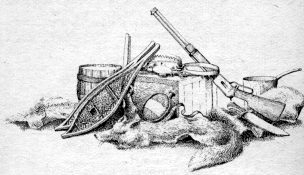 This country was still the old North, land of mystery and deep silences. The silences of summer were occasionally shattered by aircraft, or on the navigable waterways by the outboard motor of some permanent resident who, with muffler removed for extra power, ripped his big freighter canoe through the rivers and lakes enroute out to civilization or returning from it before freeze up in the fall. The occasional crack of his big game rifle, the sound of axe or saw in wood, and the yelping and howling of his dogs sometimes broke the stillness. In summer, too, the roaring of rapids and cataracts could be heard over long distances when the wind was just right in the evening stillness. The resounding crashes of great peals of thunder in the rockbound country above the Churchill River, the lonely call of the loons all summer long, the gay chorus of frogs and migrating waterfowl in spring, the whine of millions of mosquitoes in early summer-all were silenced by the congealing cold of winter when all of nature's sounds were replaced by the soughing of the cold wind through the frozen trees, the running, booming crack as the frost split thickening lake ice from shore to shore, and the occasional howling of big timber wolves from the hills in the distance.
This country was still the old North, land of mystery and deep silences. The silences of summer were occasionally shattered by aircraft, or on the navigable waterways by the outboard motor of some permanent resident who, with muffler removed for extra power, ripped his big freighter canoe through the rivers and lakes enroute out to civilization or returning from it before freeze up in the fall. The occasional crack of his big game rifle, the sound of axe or saw in wood, and the yelping and howling of his dogs sometimes broke the stillness. In summer, too, the roaring of rapids and cataracts could be heard over long distances when the wind was just right in the evening stillness. The resounding crashes of great peals of thunder in the rockbound country above the Churchill River, the lonely call of the loons all summer long, the gay chorus of frogs and migrating waterfowl in spring, the whine of millions of mosquitoes in early summer-all were silenced by the congealing cold of winter when all of nature's sounds were replaced by the soughing of the cold wind through the frozen trees, the running, booming crack as the frost split thickening lake ice from shore to shore, and the occasional howling of big timber wolves from the hills in the distance.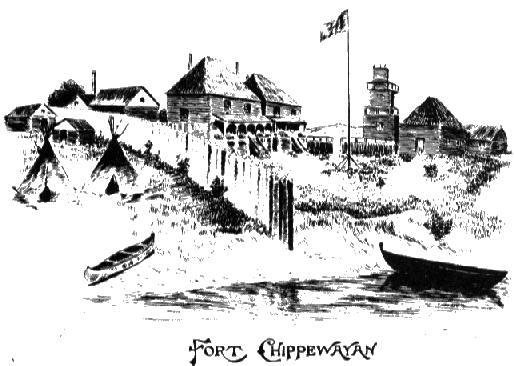 To the north, also stood the trading posts of Fort Chipewyan and Stony Rapids, yet these were more easily accessible by water than the area about which this book is written.
The Indians had been there long before the whites first came. At certain places where the rocks rose sheer along the lakeshores, hieroglyphic legends were scratched in the lichens that covered the rocks. Indian campsites were to be found on every major waterway, some so old as to be almost obliterated by time. Old Indian cemeteries were located on lakeshores or other places that had been picked as appropriate gravesites.
Down along the edges of the settlements the homesteaders were clearing land by felling trees with axes and grubbing roots by hand. The chain saw and bulldozer did not exist there.
This story tells of white men who vanished quietly into the bush in late summer and were seen and heard of no more in the frontier villages until the new leaves had opened in the following spring. It tells of their experiences that range from success and failure, heat and bitter cold, triumph and black despair, of work and sweat, of such leisure and peace as cannot be found Outside, as trappers term civilization. Everything that is told in this book has happened to someone, somewhere in the Northland. In our rapidly changing world and by its reshuffling of values, it is possible that the story of this kind of man may become distorted or lost and if this book will in any way assist to keep the record of a way of life that has now almost ceased to exist, then this is part of the book's purpose. The identity of some of the white trappers has been deliberately camouflaged for reasons that will become apparent.
To the north, also stood the trading posts of Fort Chipewyan and Stony Rapids, yet these were more easily accessible by water than the area about which this book is written.
The Indians had been there long before the whites first came. At certain places where the rocks rose sheer along the lakeshores, hieroglyphic legends were scratched in the lichens that covered the rocks. Indian campsites were to be found on every major waterway, some so old as to be almost obliterated by time. Old Indian cemeteries were located on lakeshores or other places that had been picked as appropriate gravesites.
Down along the edges of the settlements the homesteaders were clearing land by felling trees with axes and grubbing roots by hand. The chain saw and bulldozer did not exist there.
This story tells of white men who vanished quietly into the bush in late summer and were seen and heard of no more in the frontier villages until the new leaves had opened in the following spring. It tells of their experiences that range from success and failure, heat and bitter cold, triumph and black despair, of work and sweat, of such leisure and peace as cannot be found Outside, as trappers term civilization. Everything that is told in this book has happened to someone, somewhere in the Northland. In our rapidly changing world and by its reshuffling of values, it is possible that the story of this kind of man may become distorted or lost and if this book will in any way assist to keep the record of a way of life that has now almost ceased to exist, then this is part of the book's purpose. The identity of some of the white trappers has been deliberately camouflaged for reasons that will become apparent.